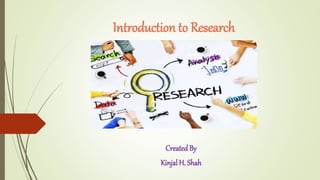
Introduction to research
- 1. Introduction to Research Created By Kinjal H. Shah
- 2. Content Introduction Etymology of Research Meaning of Research Definitions of Research Objectives of Research Types of Research
- 3. INTRODUCTION Research is a process to discover new knowledge. ... Part of the research process involves testing the hypothesis, and then examining the results of these tests as they relate to both the hypothesis and the world around you.
- 4. Etymology of Research The word research is derived from the Middle French "recherche", which means "to go about seeking", the term itself being derived from the Old French term "recerchier" a compound word from "re-" + "cerchier", or "sercher", meaning 'search'. The earliest recorded use of the term was in 1577.
- 5. MEANING OF RESEARCH Research is a way of looking for new information, new understanding, and new facts. A person who does research is called a researcher. ... Research usually prefers to be systematic, organised, and objective. Research is used in many different fields of study such as science, mathematics, and the humanities.
- 6. Definition of Research Research has been defined in a number of different ways, and while there are similarities, there does not appear to be a single, all- encompassing definition that is embraced by all who engage in it. One definition of research is used by the OECD, "Any creative systematic activity undertaken in order to increase the stock of knowledge, including knowledge of man, culture and society, and the use ofthis knowledge to devise new applications." Another definition of research is given by John W. Creswell, who states that "research is a process of steps used to collect and analyze information toincrease our understanding of a topic or issue". It consists of three steps: pose a question, collect data to answer the. Question, and present an answer to the Question.
- 7. Objectives of Research Aims and Objectives of Research Methodology Formulation of research aims and objectives in an appropriate manner is the most important aspect of your thesis because it determines.... The scope, depth and overall direction of the research Common mistakes in formulation of research aims and objectives usually relate to the following 1. Choosing the topic too broadly 2. Setting unrealistic aims and objectives 3. Choosing research methods incompatible with the timeframe available
- 9. Basic Research Basic research is a type of research approach that is aimed at gaining a better understanding of a subject, phenomenon or basic law of nature. This type of research is primarily focused on the advancement of knowledge rather than solving a specific problem.
- 10. AppliedResearch Applied research is designed to answer specific questions aimed at solving practical problems. New knowledge acquired from applied research has specific commercial objectives in the form of products, procedures or services. Fundamental research answers the initial question of how things work.
- 11. Qualitative research Qualitative research involves collecting and analyzing non-numerical data (e.g., text, video, or audio) to understand concepts, opinions, or experiences. It can be used to gather in-depth insights into a problem or generate new ideas for research.
- 12. QuaNtitative Research Quantitative research is the process of collecting and analyzing numerical data. It can be used to find patterns and averages, make predictions, test causal relationships, and generalize results to wider populations.